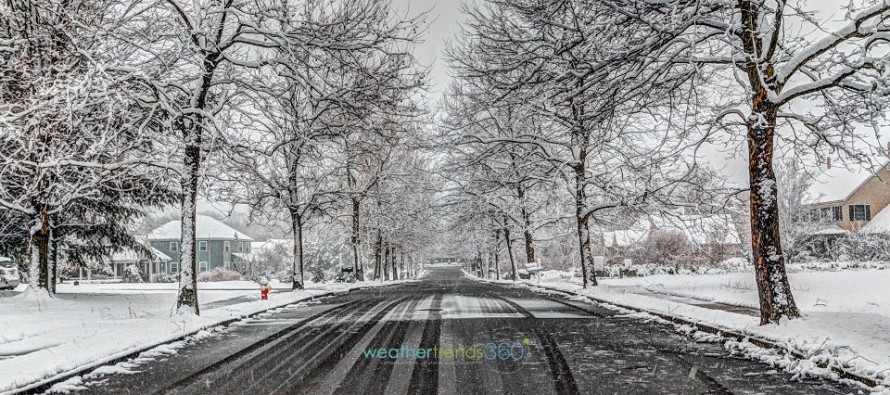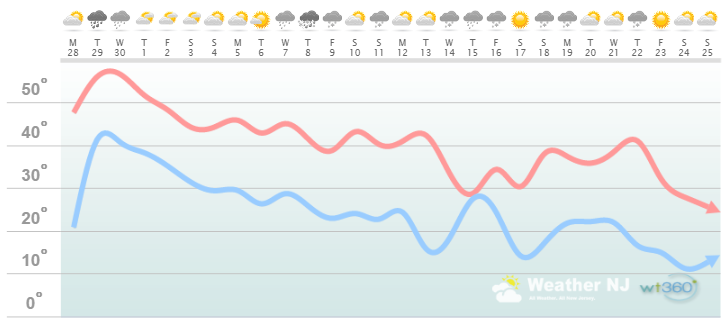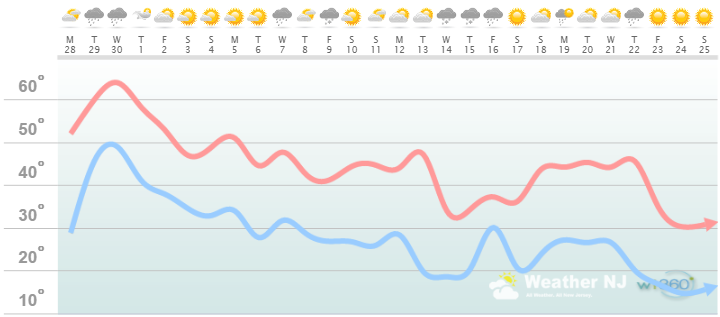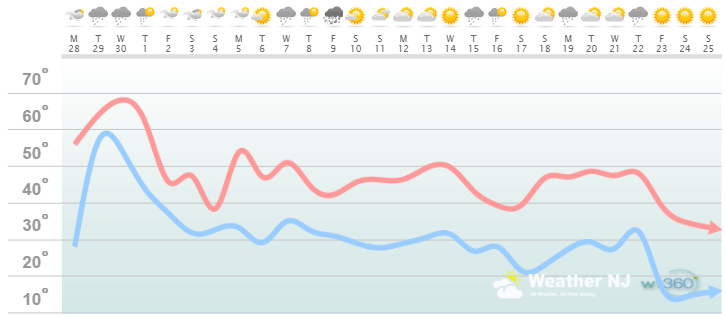What to Expect for December 2016

It’s time to harness the WeatherTrends360 proprietary weather algorithms to see how December of 2016 should play out. But first lets break New Jersey into proper climatological regions. We have the higher elevations of NNJ/NWNJ, the interior coastal plain (SWNJ through CNJ and into NENJ), and the coastal regions (most of SENJ). I’ll be representing each climatological region with a 28-day graph from weathertrends360 data followed by a brief discussion. Please keep in mind that these algorithms are documented with an 84% verification rate and are based on oceanic water cycles, time table series and very complex mathematics. The best takeaway from this are general trends (cool vs warm, rainy vs dry, etc). That’s what WeatherTrends360 does best with their proprietary mathematical analysis derived from over 150 years of reactive pattern data.
Higher Elevations of NNJ/NWNJ
(Sussex, Warren, Hunterdon, Morris, N. Somerset, and N. Passaic) – Known for little to no Atlantic Ocean influence, colder-snowier winters, and drier conditions in general when compared to the coast. This region is known to get hot when high pressure sits overhead during the summer and bitterly cold during Arctic outbreaks in the winter. Elevation is a major influence that separates this micro-climate from the rest of New Jersey. This region extends into NE PA (Poconos) and parts of NY State (Catskills).
Higher Elevation Discussion: As the graph indicates, milder temperatures should subside with the start of December. Temperatures should then steadily decline heading into Christmas with highs eventually struggling to get out of the 20s/lower-30s. Once we’re half-way through December, lows in the teens/single-digits should come into play, especially if we see any Arctic/polar vortex outbreaks. Precipitation chances are favored in the Dec 7-11, 14-16, and 18-22 periods. We’ll have to watch for any wintry precipitation possibilities in those time frames. Overnight temperatures will be plenty cold enough to support snow but daytime high temperatures could present a marginal temperature profile. Regardless, December looks to confirm the “front-loaded winter” theory that EPAWA and I have been discussing in recent articles.
Interior Coastal Plain from SWNJ-CNJ-NENJ
(Salem, Gloucester, Camden, W. Burlington, Mercer, W. Monmouth, Middlesex, S. Somerset, Union, Essex, Hudson, Bergen, and S. Passaic) – Known for naturally higher temperatures due to lower elevations away from the oceanic influence. This region is also known as “heat island” due to transportation (I-95 corridor), smog, abundant asphalt, concrete, and other man-made substances that naturally absorb and retain heat moreso than natural protected land. This is why excessive heat warnings and air quality alerts are more common in this region. SWNJ always tends to run a few degrees warmer than NENJ but this region is very similar otherwise in micro-climate due to the parallel nature of the Appalachian Mountain elevations to the NW. The same micro-climate can be extended into SE PA and NE MD which tends to run just a little stormier than NJ. This however is what makes up the interior coastal plain.
Interior Coastal Plain Discussion: As the graph indicates, milder temperatures should subside with the start of December. Temperatures should then steadily decline heading into Christmas with highs eventually struggling to get out of the 30s. Once we’re half-way through December, it’s game-on for this region winter-wise as overnight lows fall below freezing almost every night and highs struggle to break 40. Precipitation chances are favored in the Dec 7-11, 14-16, and 18-22 periods. We’ll have to watch for any wintry precipitation possibilities in those time frames. Regardless, December looks to confirm the “front-loaded winter” theory that EPAWA and I have been discussing in recent articles. While Dec 21 is the official first day of winter, mother nature might be slightly impatient by a week or two.
Coastal Regions of SENJ
(Cumberland, Cape May, Atlantic, E. Burlington, Ocean, and E. Monmouth) – Known for tremendous influence from the Atlantic Ocean. Oceanic influence keeps this zone cooler in the summer and warmer in the winter than the interior coastal plain and especially the higher elevations of NWNJ. In the summer, sea breeze fronts back into the coast and can ignite thunderstorms if enough instability is present. The cooler marine air slides under the hot air to the W and provides additional atmospheric lifting. This is both why it’s 5-15 degrees cooler at the shore than the Philly-Trenton area and why near-stationary thunderstorms can form along the coast capable of producing localized flash flooding. In the winter, the ocean is warmer than interior regions which plays a huge role in rain vs. snow—highly dependent on wind direction. When the winds chance from NE to N/NE, that’s usually when temps crash and change rain over to snow. Regardless, this micro-climate is well known, well documented and well expressed. This region extends into most of Delaware as well.
Coastal Region Discussion: As the graph indicates, milder temperatures should subside with the start of December. Temperatures should then steadily decline heading into Christmas with highs eventually struggling to get out of the 30s. Highs should still reach well into the 40s until Christmas. Keep in mind that this region is heavily-dependent on ocean surface temperatures which are still in the upper-40s/lower-50s. This region has better snow chances in late-January/February when ocean surface temperatures bottom out in their annual cycle (slightly below 40). As we’ve seen before, coastal regions can see snow in December but it is on the rarer side. With that said, I wouldn’t expect the winter slam that interior and elevated locations (the other two regions above) could see. I would however expect a colder pattern to settle in anytime after the first week of December. Precipitation chances appear more scattered through the entire month. For precipitation to fall as frozen types, it would likely have to be overnight and in the second half of the month. This region is simply not there yet for the first half of December. I’ll be keeping a close eye on this though.
In English: The milder temperatures that are closing November out are coming to a rest. Arctic and Pacific jet stream dynamics are looking favorable for a winter kick-start anytime after the first week of December. This should be felt moreso for elevations and interior areas away from the ocean. Coastal areas (especially SENJ) will need some more time for winter to truly kick-in despite an overall colder pattern change. The same oceanic influence that provides dreamy summer weather for the coast (70s when the rest of NJ is baking in the 90s) will buffer temperatures on the warmer side until we’re well into January/February. Overall, a front-loaded winter is knocking on New Jersey’s door and I’ll be there to properly forecast any wintry disturbances that come into fruition.
Weathertrends360 is a complete, global, web solution to help retailers and suppliers capitalize on the weather and its influence on sales and marketing plans up to a year ahead. Learn how to become PROACTIVE vs REACTIVE with the weather in every phase of your business – how much inventory to buy/produce, where to allocate more/less, when to run weather-optimized advertising/marketing campaigns – weathertrends360 can help you determine all of this in minutes! 84% independently audited accuracy for both short-term and year-ahead forecasts for temperature and precipitation.
A forecast Weather Trends issued one year ago is more accurate than every other weather company’s 5 to 14-day forecasts. The University of Miami and West Point PhD Climatologist’s prove WTI’s year-ahead forecasts are several times more accurate than NOAA.
Have a great December and please be safe! JC
Jonathan Carr (JC) is the founder and sole operator of Weather NJ, New Jersey’s largest independent weather reporting agency. Since 2010, Jonathan has provided weather safety discussion and forecasting services for New Jersey and surrounding areas through the web and social media. Originally branded as Severe NJ Weather (before 2014), Weather NJ is proud to bring you accurate and responsible forecast discussion ahead of high-stakes weather scenarios that impact this great garden state of ours. All Weather. All New Jersey.™ Be safe! JC












